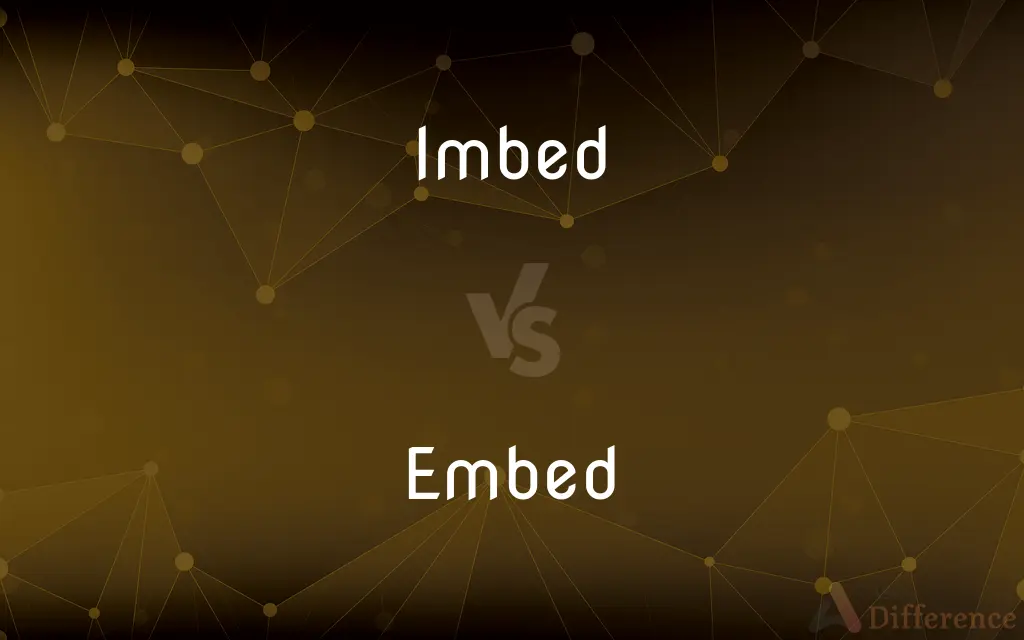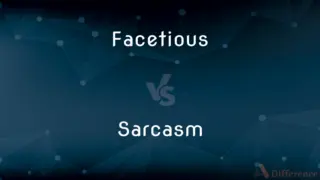Imbed vs. Embed — What's the Difference?
By Urooj Arif & Fiza Rafique — Updated on April 15, 2024
"Imbed" and "embed" both imply placing something deeply within another material, but "embed" is far more commonly used in all contexts.

Difference Between Imbed and Embed
Table of Contents
ADVERTISEMENT
Key Differences
"Imbed" is an alternative spelling of "embed," which is the standard term used to describe placing an object deeply within another, such as embedding a post in concrete. While "embed" enjoys wide usage across various contexts, including digital media (embedding a video into a webpage), "imbed" appears less frequently and often in more specialized or older texts.
Both terms convey the action of deeply inserting one thing inside another. However, "embed" is preferred in both technical and general usages, such as embedding a tweet in a blog post or embedding stones in jewelry. In contrast, "imbed" might be seen in certain scientific or medical contexts, but even there, "embed" is commonly accepted and used.
In terms of etymology, both words stem from the Latin root "bed" (a place of rest), combined with the prefix "em-" or "im-" (in or into), indicating putting into or inside something. Despite their common roots, the usage trend strongly favors "embed," reflecting its broader acceptance in contemporary English.
When discussing technology or media, "embed" is almost exclusively used, such as in "embedded systems" in computing or embedding content on websites. On the other hand, "imbed" rarely appears in these contexts, maintaining a presence primarily in niche academic or technical documents.
"Embed" also functions in various grammatical forms widely recognized and utilized, such as "embedded" or "embedding," which are used in both active and passive constructions. "Imbed," while it can be used similarly, does not appear as frequently in the lexicon of modern English speakers.
ADVERTISEMENT
Comparison Chart
Common Usage
Less common, more often seen in older or specialized texts.
Widely used in all contexts, especially in digital media.
Contexts
Sometimes used in scientific or medical contexts.
Used across various fields, including technology, journalism, and general discourse.
Etymology
Derives from Latin "in" + "bed" (to place into).
Derives from Latin "in" + "bed" (to place into).
Example Usage
Rarely used in everyday conversation.
Commonly used in descriptions involving digital content and technical descriptions.
Grammatical Forms
Forms like "imbedded" and "imbedding" are less common.
Forms like "embedded" and "embedding" are frequently used.
Compare with Definitions
Imbed
To enclose tightly or firmly.
The artifact was imbedded in amber.
Embed
To incorporate or integrate closely.
The software developer embedded the code into the application.
Imbed
To fix an object firmly and deeply in a surrounding mass.
They decided to imbed the sculpture in the center of the hall.
Embed
To fix something firmly and deeply in a surrounding mass.
The engineer embedded the steel bars in concrete.
Imbed
Rare alternative spelling of "embed" used in certain contexts.
The study discusses how fossils were imbedded in the rock.
Embed
Common in digital and media contexts.
Embedding links into your blog posts can enhance user engagement.
Imbed
To plant or set securely or deeply.
He imbedded the post deep into the ground to ensure stability.
Embed
Standard spelling in modern usage across contexts.
You can embed a video into your webpage easily.
Imbed
Occasionally used in medical or dental contexts.
The shard was imbedded in his arm and required surgery.
Embed
To involve deeply, as in embedding oneself in a culture.
She embedded herself in the local community to better understand their issues.
Imbed
Variant of embed.
Embed
To fix firmly in a surrounding mass
Embed a post in concrete.
Fossils embedded in shale.
Imbed
Alternative spelling of embed
Embed
To cause to be an integral part of a surrounding whole
"a minor accuracy embedded in a larger untruth" (Ian Jack).
Imbed
To sink or lay, as in a bed; to deposit in a partly inclosing mass, as of clay or mortar; to cover, as with earth, sand, etc.
Embed
(Linguistics)To insert or position (a clause or phrase) within a clause or phrase.
Imbed
Fix or set securely or deeply;
He planted a knee in the back of his opponent
The dentist implanted a tooth in the gum
Embed
(Computers)To insert (a virus, for example) into a software program.
Embed
To assign (a journalist) to travel with a military unit during an armed conflict.
Embed
(Biology)To enclose (a specimen) in a supporting material before sectioning for microscopic examination.
Embed
To become embedded
The harpoon struck but did not embed.
Embed
One that is embedded, especially a journalist who is assigned to an active military unit.
Embed
(transitive) To lay (something) as in a bed; to lay in surrounding matter; to bed.
To embed something in clay, mortar, or sand
Embed
To include (something) in surrounding matter.
We wanted to embed our reporter with the Fifth Infantry Division, but the Army would have none of it.
Embed
To encapsulate within another document or data file.
The instructions showed how to embed a chart from the spreadsheet within the wordprocessor document.
Embed
To define a one-to-one function from one set to another so that certain properties of the domain are preserved when considering the image as a subset of the codomain.
The torus can be embedded in .
Embed
(journalism) An embedded reporter or journalist, such as a war reporter assigned to and travelling with a military unit, or a political reporter assigned to follow and report on the campaign of a candidate.
Embed
An element of an advertisement, etc. serving as a subliminal message.
Embed
(computing) An item embedded in another document.
Embed
To lay as in a bed; to lay in surrounding matter; to bed; as, to embed a thing in clay, mortar, or sand.
Embed
Fix or set securely or deeply;
He planted a knee in the back of his opponent
The dentist implanted a tooth in the gum
Common Curiosities
What does it mean to embed a video?
Embedding a video involves integrating it into a webpage or digital document so it can be viewed directly within the page.
What is the difference between imbed and embed?
"Imbed" is an alternate spelling of "embed," but "embed" is more commonly used.
Why is embed more popular than imbed?
"Embed" is more universally accepted and used in a wider range of contexts, especially in technology and media.
Is imbed incorrect to use?
No, it is not incorrect, but it is less common and may be viewed as outdated in some contexts.
Are imbed and embed interchangeable?
Yes, in most contexts, though "embed" is favored for clarity and common usage.
How do I embed content on a website?
Embedding content typically involves using a piece of code or a widget provided by the content source that allows it to be displayed on another site.
How do I use embed in a sentence?
You can use it like this: "The journalist embedded with the troops to get a closer look at the conflict."
Can I use imbed in academic writing?
Yes, though "embed" is generally preferred and more widely recognized.
Are there any synonyms for embed?
Yes, synonyms include implant, insert, encase, and entrench.
What are embedded systems?
Embedded systems are computer systems with a dedicated function within a larger mechanical or electrical system, often with real-time computing constraints.
Can embed have different meanings?
Yes, it can refer to both the physical insertion of an object into another and the integration of data or media into digital platforms.
What are the implications of using embed in technology?
In technology, using embed refers to incorporating various types of content into digital platforms, enhancing functionality and user experience.
What does it mean to be embedded in a culture?
Being embedded in a culture means deeply engaging and immersing oneself in the daily life and practices of the community.
What is the verb form of embed?
The verb forms are embed, embedding, embedded. "Embed" is the present tense, "embedding" is the present participle, and "embedded" is the past tense and past participle.
Is there a noun form of embed?
Yes, the noun form is "embedment," referring to the act or process of embedding or the state of being embedded.
Share Your Discovery

Previous Comparison
Unartful vs. Inartful
Next Comparison
Facetious vs. SarcasmAuthor Spotlight
Written by
Urooj ArifUrooj is a skilled content writer at Ask Difference, known for her exceptional ability to simplify complex topics into engaging and informative content. With a passion for research and a flair for clear, concise writing, she consistently delivers articles that resonate with our diverse audience.
Co-written by
Fiza RafiqueFiza Rafique is a skilled content writer at AskDifference.com, where she meticulously refines and enhances written pieces. Drawing from her vast editorial expertise, Fiza ensures clarity, accuracy, and precision in every article. Passionate about language, she continually seeks to elevate the quality of content for readers worldwide.
















































